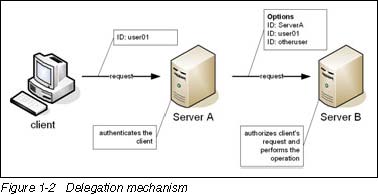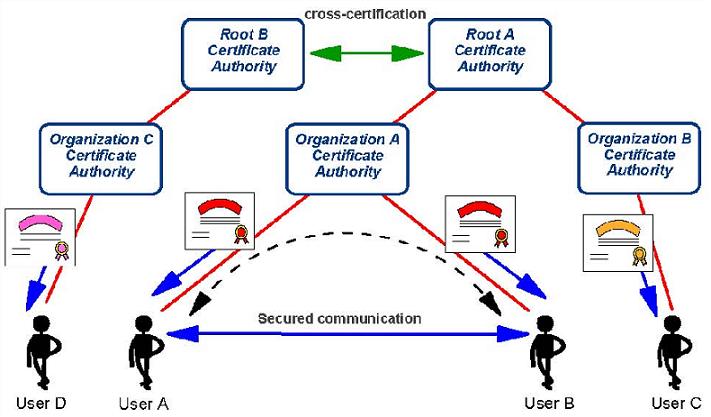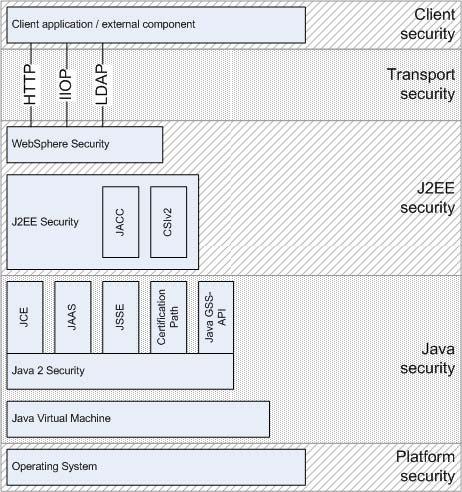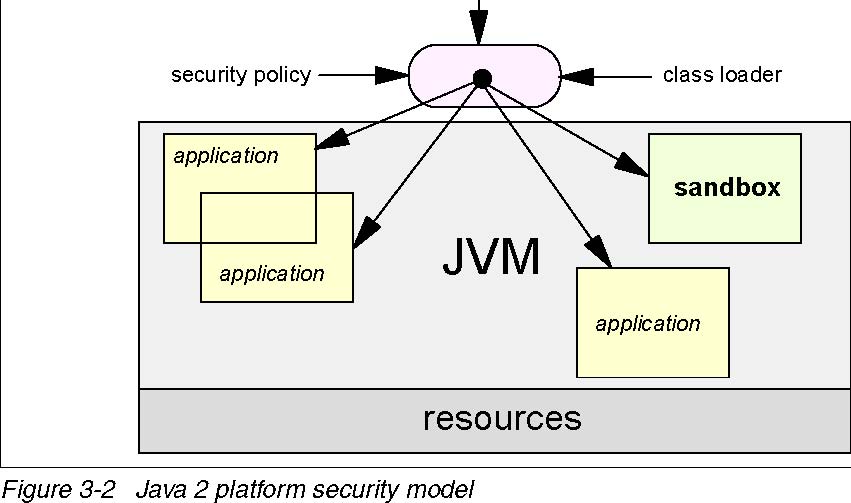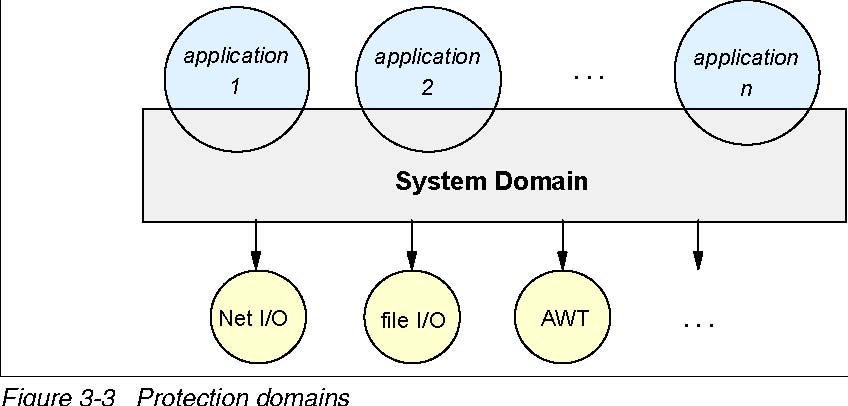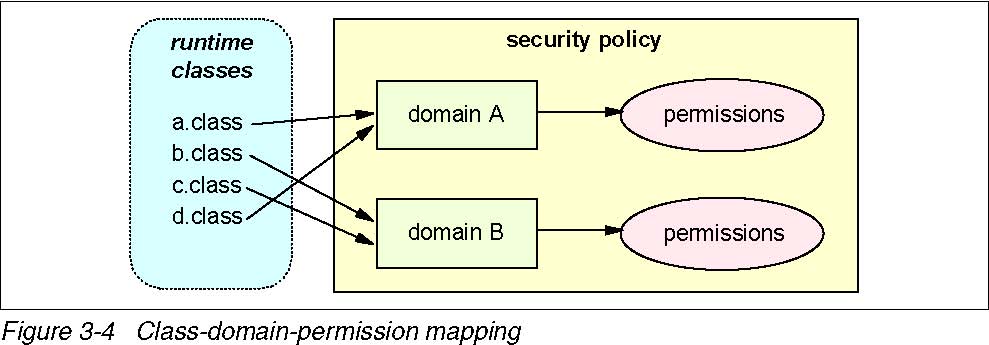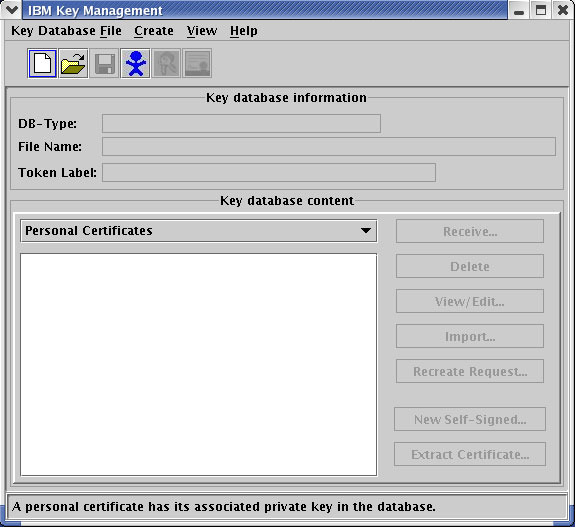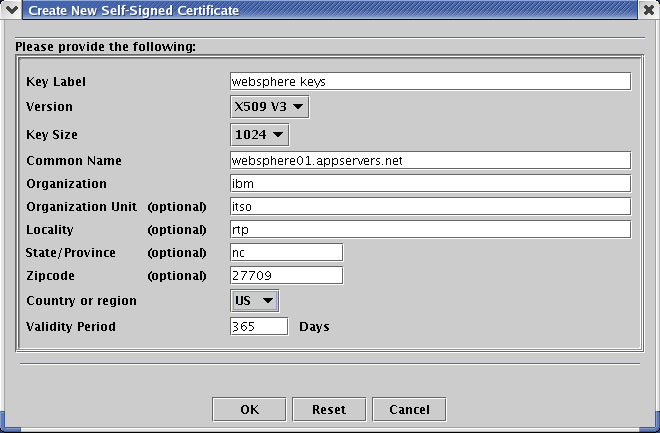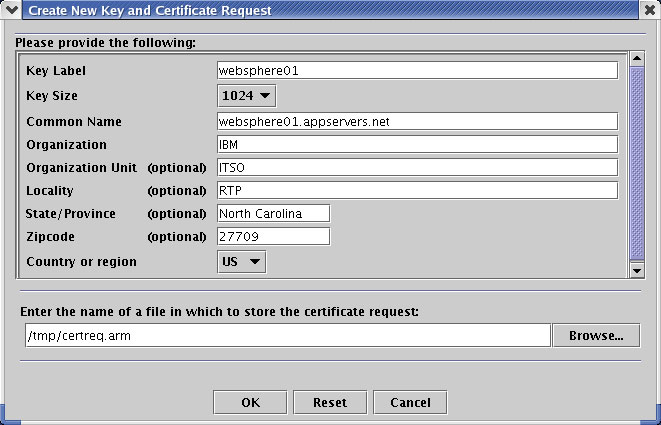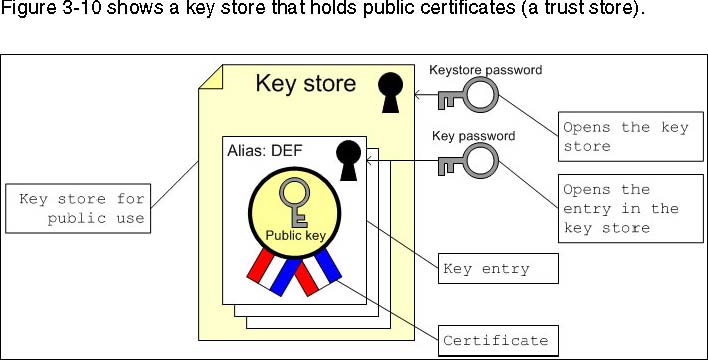WebSphere Security Fundamentals
- Physical security
- Logical security
- Security policy
- Authentication
- Authorization
- Secure communication
- Security in use
- Supporting security components for WebSphere
- User registry (or directory)
- Authorization and authentication server
- Security reverse proxyserver
- Public KeyInfrastructure (PKI)
- Kerberos
- Firewall
- Security for J2SE, J2EE, and WebSphere
- Introduction
- Java 2 security
- Basic cryptography
- Authentication
- Authorization
- Secure connection
- Security context
- Web security
- Web authentication mechanisms
- Security tools
- ikeyman
- J2SE 1.4 security tools
Physical security
Physical security protects against intrusion and damage to...
- Any machine where the application is running
- The room where the machines are operating
- The building where the machines are installed
- The site where the company is located
- Ground lines
- Wireless connections
The communication network must be protected against eavesdropping and damage to the connection (such as cutting the line).
Logical security
Logical security is related to particular IT solutions: the IT architecture and applications, including the business processes.
Communication
Network communication must be protected not only on a physical level but on a logical level as well. Most companies’ networks are connected to public networks, making applications accessible from the outside world. Network-level security must prevent unauthorized access.
Application
An application is secured on different levels. Security is involved from the very beginning of the implementation, when the processes and flows are designed.
- Securing the resources
This implies protecting the resources on an application level and exercising the security features of the runtime platform (authentication and authorization).
- Implementing the business processes securely
The processes must be designed in a way that no weakness in logic can be found.
Security policy
Security policies are guidelines for an organization; they can be part of a widely accepted standard (ISO) or implemented by a certain organization or company.
Policies can define processes for different areas in an organization. Security policies focus on security-related processes (for example, how to request a new password, how to renew a password, and so on).
These guidelines are very important in implementing a robust security policy for the whole system organization-wide.
Authentication
Authentication is the process of establishing whether a client is valid in a particular context. A client can be an end user, a machine, or an application.
A realm is a collection of users that are controlled by the same authentication policy.
The authentication process involves gathering some unique information from the client. Three major groups of secure authentication are used to gather this unique information:
Knowledge-based user name and password, for example
Key-based physical keys, encryption keys, and key cards
Biometric fingerprints, voice patterns, and DNA Other authentication mechanisms can combine these; an example is digital certificates, in which key-based and knowledge-based authentication are exercised.
User name and password
User name and password are the most common method for authentication. The user who wants to access the system logs on with a user name and a password, which are compared to the values stored in the system.
Physical keys
Physical keys are objects that can be used to prove the identity of the object holder: the metal key that is used to unlock your computer, a hardware device that is plugged into the computer to execute certain programs, or a smart card with an embedded memory or microprocessor.
Biometric authentication
Biometric authentication is the use of physiological or behavioral characteristics to verify the identity of an individual. Biometric authentication consists of comparing the physical characteristics of an individual against the values of those characteristics stored in a system.
Re-authentication
Re-authentication occurs when the user is required to authenticate again some time after a successful authentication. Re-authentication might be used in any of these cases:
- The user is trying to access a new application that does not belong to the security domain where the user is already logged in, and there is no single sign-on solution in place to avoid re-authentication.
- The time period for the user session expires after a certain time, so the user has to re-authenticate to continue the existing session or to start a new one.
- The user needs to change identity or add a new identity (subject) to the existing session.
Impersonation
Impersonation is when a subject (user or system) acts in behalf of another subject. An existing identity can pick up an additional, new identity or switch to another identity and use the new identity to present itself.
Delegation
Delegation is the ability to leave an intermediary to do the work initiated by a client according to a delegation policy.
For example, in a distributed object environment, a client can request the method of an object on server A. The method request results in invoking another method of an object in server B. Server A performs the authentication of the identity of the client and passes the request to server B. Server B assumes that the client identity has been verified by server A and responds to that request.
Depending on the application environment, the intermediary can have one of the following identities when making a request to another server:
- Client identity
The identity under which the client is making the request to the intermediary
- System identity
The identity of the intermediary server
- Specified identity
The identity specified through configuration
Single Sign-On
Single Sign-On is a convenient function for environments with multiple secured applications. Most of these applications usually require authentication, but they:
- May have different authentication mechanisms
- May have different user registries
- May require a different identity from the same user
To avoid another authentication during the same session, Single Sign-On takes care of the further authentication steps on behalf of the user.
Single Sign-On can be a function supported on the application level or application server level, or it can be an additional component in the security infrastructure that takes care of authentication.
Authorization
Authorization is the process of checking whether the authenticated user has access to the requested resource. There are two fundamental methods:
- Access control list
- Capability list
Access control list
Each resource has associated with it a list of users and what each can do with the resource (for example: use, read, write, execute, delete, or create).
Usually, an access control list specifies a set of roles that are allowed to use a particular resource. It also designates the people allowed to act in these roles.
For example, in a bank account object, we can have different methods (transfer, deposit, getBalance, setInterest). The access right can be granted on the basis of the roles of the users within the organization. A bank teller can have access to the getBalance method but not to setBalance, while a manager can have access to both methods.
Resources Bank teller role Manager role getBalance method yes yes setBalance method no yes
Capability list
Associated with each user is a list of resources and the corresponding privileges held for the user.
In this case, the holder is given the right to perform the operation on a particular resource.
In the previous example of the bank account object, the access right is granted to the user if the resource is listed in the user’s capability list.
Roles getBalance method setBalance method Bank teller role yes no Manager role yes yes Table 1-1 and Table 1-2 are very similar, but the rows and columns are switched. Actually, this is the difference between the two approaches. We have two sets: roles and resources. In the first case, roles are mapped to resources, and in the second case resources are mapped to roles.
The access control list is exercised generally, because managing security for certain resources is easier and more flexible than mapping resources to roles.
Role-based security
Roles are different levels of security that relate to a specific application. Different employees have different roles, so the security access that each employee requires to complete the tasks in a Web application are also different. In a role-based authorization model, the roles for a given application are developed as the application is developed. As a user base for the application is established, one of three things happens:
- Users are mapped directly to specific security roles.
- Groups are formed, users are defined as members of a group, and the groups are defined to specific security roles.
- A combination of user/group mapping to security roles is used to handle any exceptions.
Secure communication
Secure communication protects transmitted data against eavesdropping. In a secured communication, the data is encrypted during the transport.
Note: There is a significant difference between encoding and encrypting.
Encoding is the process of transforming data into another form of representation based on rules. These rules define the mapping between the original character and their representation. The transformation is easily reversible.
Encrypting is the process of transforming data into an entirely new set of data. The transformation is based on complex algorithms to ensure that there is no (or very little) correlation between the original data and the transformed data. In an ideal situation, transformation is non-reversible; in reality it is very hard to reverse.
The secured communication always starts with a “handshake” or contract. During the handshake, the parties can agree on the nature and the details of the secure communication, for example: authenticate each other and agree on a method to use for encrypting the messages.
Security in use
Basic security areas include:
- Authentication / identification
Measures designed to protect against fraudulent transmission and imitative communications by establishing the validity of transmission, message, station, or individual.
- Access control
The prevention of improper use of a resource, including the use of a resource in an unauthorized manner.
- Privacy / confidentiality
Assurance that information is not made available or disclosed to unauthorized individuals, entities, or processes.
- Data integrity
The correctness of information, of the origin of the information, and of the functioning of the system that processes it.
- Accountability / non-repudiation
Assurance that the actions of an entity may be traced uniquely to the entity. This ensures that there is information to prove ownership of the transaction.
- Administration / configuration
Methods by which security policies are incorporated into the architecture and the functionality that the system architecture needs to support.
- Assurance / monitoring
Confidence that an entity meets its security objectives; this is usually provided through an intrusion detection system.
- Security management
Assurance that an entity meets its security management objectives, processes, and procedures.
Supporting security components for WebSphere
This chapter is an introduction to the external (to the application server) components that support WebSphere to improve security for the whole environment. End-to-end security always includes more than the application server with the applications. Various other components work with the application server to provide security services for applications.
User registry (or directory)
User registry is a key component for applications. It is responsible for holding information about users, identities, and groups for security domains. There are many different type of user registries available, including:
- LDAP (Lightweight Directory Access Protocol) server
- Database-based user registry
- Operating system’s user registry
- File-based user registry
The most common user registry today is the LDAP directory, or other user registries supporting LDAP to query users (for example: Domino directory).
User registries have different methods for organizing users in the registry. Generally users and groups are mapped to some type of hierarchy in the user registry, possibly following the company’s organizational structure.
Authorization and authentication server
The authorization and authentication server (security server) is a key component in centralizing security in the company. The server can evaluate authentication and authorization requests on behalf of the application servers. Application servers have to externalize these security functions. In a proper environment the application servers trust the security server and they do not even do user registry lookups any more, leaving that to the security server.
Authentication is a relatively simple function to externalize. Most of the authentication mechanisms are well defined for the different application servers. Authentication is performed only a few times during a session, so externalizing such a function should not have a significant impact on performance.
Authorization is a more complex function in the sense that different application servers define authorization entries in different ways, and authorization can be applied to many different components and actions defined on the components. Centralizing such a function requires flexibility from the security server. An authorization check is performed several times during a session, every time a secured resource is accessed, so externalizing the function may make a significant performance impact.
Security reverse proxy server
The security reverse proxy server resides between the Web clients and the Web application server. This server’s responsibility is to intercept incoming calls from the clients and perform authentication and authorization on behalf of the application server running the Web application.
By acting as a single point of entry for the clients, this server increases security in the environment. However, it can also be considered a bottleneck in the network infrastructure. Security reverse proxy servers are usually high-performance servers; or we can load-balance between a few of them for better performance.
Public Key Infrastructure (PKI)
PKI is closely related to cryptography. Although it seems complicated, it is not. We do not explain the details or go into low-level mathematical algorithms here, but you should understand the background involved.
Secret key cryptography
Secret key algorithms, which use one key to encrypt and decrypt the data, were invented before public key algorithms.
The algorithms that are used provide a great advantage: They are faster than public key cryptography. They have a considerable disadvantage as well: The same key is needed for encryption and decryption, and both parties must have the same keys. In today’s cryptography, the secret keys do not belong to persons but to communication sessions. At the beginning of a session, one of the parties creates a session key and delivers it to the other party; they can then communicate securely. At the end of the session, both parties delete the key and, if they want to communicate again, must create another key.
The following section discusses how to secure the delivery of the session key.
Public key cryptography
The first imperative of public key cryptography is the ability to deliver session keys securely.
Public key cryptography involves the use of different keys for encrypting and decrypting functions. If you encrypt something with key 1, we can only decrypt it with key 2, as shown in Figure 2-2.
This architecture allows the use of one of the keys as a private key. This means that nobody can have access to this key except the owner. The other key can be used as a public key. If a user wants to send an encrypted message to another person, he or she will get the other person‘s public certificate, encrypt the message and send it. The message can be decrypted only by the owner of the private key.
Figure 2-3 on page 14 shows a sample communication between two persons: Alice and Bob.
- Alice wants to communicate with Bob but she does not want anybody to read the messages. She will use Bob’s public key to encrypt the message.
- Alice sends the message to Bob.
- Bob uses his private key to decrypt the message.
If Bob wants to answer, he should use Alice’s public key for encryption.
This example is not suitable for the encryption of large amounts of data, because public key algorithms are very slow. We use the secure key algorithms to transmit large amounts of data. The session keys must be delivered with the public key algorithm and will be used during the communication.
This is the concept that SSL follows to establish a secure communication.
Certificates
A certificate is a document from a trusted party that proves a person’s identity. PKI certificates work in a similar way: If someone has a certificate from a trusted party, we can make sure of his or her identity.
Signatures
Signatures also work as in everyday life. For signatures used in the PKI environment, the information encrypted with a person’s (the sender) private key is unique to this person. Anybody can decode the message, and the source will be identified, because only one public key can open the message: the sender’s public key. This message is almost good enough to be used for a digital signature; the only problem is that we would like to sign documents, and an encrypted document is too long to be a signature.
Signatures are not enough for identification. For example, when someone wants to travel by air, a passport has to be shown as proof of identification. The certificate, similar to a passport, is issued by a trusted authority. It should contain information about the owner and should be signed by the authority.
The standard that defines the form of a certificate is called X.509. This standard also defines the attributes of a certificate, for example: X.500 name, issuer’s name, distinguished name, serial number, and so on.
Elements of a certification authority system
A PKI system completes the tasks related to public key cryptography. These tasks should be separate, meaning that a PKI system should have some well-defined units to execute the different tasks. In some cases, the PKI implementation must separate the different functions physically (for example, in a commercial CA system). In this case, the elements listed next are located on different servers.
The logical elements of a PKI system are:
- Certificate Authority (CA)
- Registration Authority (RA)
- Certificate Repository (CR)
Certificate Authority (CA)
The CA component is the heart of a PKI system; it provides the “stamp” to the certificate. In some implementations, the CA component is issued with the Registration Authority component. It stores its private key and can sign the certificate requests with it. This private key should be kept in a very secure place. If this key is corrupted, the whole certification tree will be unusable. This key can be stored on separate hardware.
Registration Authority (RA)
This component is responsible for the registration process. It is an optional component of a PKI system but, in most cases, it is implemented. The main RA task is the verification of client requests.
Certificate Repository (CR)
This component is often called a certificate directory. The users of a PKI system use the issued certificates to authenticate themselves. When someone receives a signed message, the receiver checks the signature. If the signature was issued by a trusted party, the message is considered a trusted message. Otherwise, there is a problem. The certificate could have been revoked (for example, the owner left the company), so it should not be considered trusted. This problem is solved by publishing certificates in the certificate repository. When a user receives a message with a certificate, the validity of the certificate can be verified.
The list of revoked certificates is called Certificate Revocation List (CRL) and is usually stored in the CR. The most common way to implement a CR is to use the Lightweight Directory Access Protocol (LDAP) standard (RFC2587).
Certification process
Usually, there are two methods to issue certificates. The difference between the processes is the location where the client’s private key will be generated.
In the first case, the client key pair is generated on the client side (on the client machine). The client creates a certificate request, which contains some information about the client (public key, name, e-mail address, key usage, some optional extensions, and so on). The request is signed with the private key of the client and sent to the server. The server identifies the client before issuing the certificate. The first step is to verify whether the signature at the end of the request is valid. (The public key in the request can be used for validation.) If no error is encountered, then either the certificate can be issued or another client validation process can be started. The most secure method of client validation is for the client to appear personally and certify themselves at the authority location. If the client certification is successful, the certificate for the public key is created with the desired key usage. The client can download the certificate into his or her browser registry or onto a smart card.
The other way to issue certificates is to execute the key generation process on the server side. This means that private keys are created on the server side. This solution presents some problems:
- Key generation requires a lot of computing power. There should be very powerful computers applied as Certificate Authority (CA) machines or key generation will be very slow (in case of multiple requests).
- The private key must be issued and sent to the client, creating a weak point in the security.
In some situations, this method is better for issuing certificates. For example, a research institute with a few hundred employees wants to make the entrance of the building more secure and wants the computers to be used by appropriate people. The company decides to use smart cards for solving both problems. A PKI system can be implemented and every employee can get a smart card with a certificate and a private key. Obviously, the company will not establish a Web registration module for the employees (because of the fixed and small number of certificates to issue), but it will create the keys and certificates, install them on the cards, and issue the cards to the employees. This process does not have any weak points, because the cards are given personally to each person. Smart cards usually do not allow the exporting of private keys, so they cannot be corrupted (unless the card is stolen).
Self-signed certificates
Self-signed certificates can be used in a trusted environment in which the two parties do not need a third party to certify them. To ensure the trust between the two parties, the certificates are exchanged between the two in a secure manner, prior to any contact.
Self-signed certificates are convenient in internal applications and intranet environments. They are not sufficient when the parties cannot exchange certificates in a secured, trusted manner, or when the communication happens ad hoc between two parties who do not know about each other.
Infrastructure
A Public Key Infrastructure (PKI) system acts as a trusted third-party authentication system, issuing digital certificates for the communication parties (users and applications). Some of its tasks are:
- Issuing certificates
- Revoking certificates
- Renewal of certificates
- Suspension and resumption of certificates
- Management of issued certificates
- Issuing a list of revoked certificates
- Protection of the private key
The depicted certification scenarios are:
- When User A wants to talk to User B, both of their certificates are issued and signed by the same Certificate Authority (Organization A); they can trust each other, and the secure communication is built based on the trust.
- When User A or User B wants to talk to User C, their certificates come from the same Root Certificate Authority (Root A); they can trust each other again. This scenario shows the hierarchy of the certificates, where the certificate has been signed by a chain of CAs. As long as the two parties have mutual Certificate Authorities along the line, they can trust each other.
- When User D wants to talk to User A or User B or User C, their certification paths are different. To resolve the problem, the two root Certificate Authorities (Root A and Root B) can create a trust between themselves by setting up a cross-certification. When the two parties have cross-certified CAs along the path, they can trust each other.
Kerberos
Kerberos is a network authentication protocol. It is designed to provide strong authentication for client/server applications by using secret-key cryptography.
“The Kerberos protocol uses strong cryptography so that a client can prove its identity to a server (and vice versa) across an insecure network connection. After a client and server have used Kerberos to prove their identity, they can also encrypt all of their communications to assure privacy and data integrity as they go about their business.” (from the MIT Kerberos Web site)
We can find more information about Kerberos at:
http://web.mit.edu/kerberos/www/
Firewall
Firewalls are key network infrastructure components in security. They have many functions that help to separate network segments and provide services to connect them.
By separating network segments, the communication can be controlled on the protocol level between clients and servers.
A few security functions that firewalls can provide:
- Hide actual server names and addresses from outside connections.
- Filter communication based on originating addresses.
- Filter communication based on protocols.
- Authenticate connecting clients.
Security for J2SE, J2EE, and WebSphere
This chapter is about security fundamentals in Java 2 Platform, Standard Edition (J2SE), J2EE, and particularly IBM WebSphere Application Server.
The purpose of this chapter is to give you a high-level overview about almost everything that is related to security in the scope we defined in the title. We do not cover everything in depth, but at least mention everything and give you a reference for further research.
Introduction
This may have a strong influence on the WebSphere security configuration (that is stored in the file system) and the overall application runtime security environment.
WebSphere Application Server security sits on top of operating system security and the security features provided by other components, including the Java language, as shown in Figure 3-1.
- Operating system security should be considered in order to protect sensitive WebSphere configuration files and to authenticate users when the operating system user registry is used for authentication. This is extremely important in a distributed WebSphere environment when potentially different operating systems and different user registries might be involved. Keeping users (and
their passwords) and groups in sync across many different machines might be a problematic administration task.
- Standard Java security is provided through the Java Virtual Machine (JVM) used by WebSphere and the Java security classes.
- Java 2 security enhances standard JVM security by introducing fine-grained access, easily configurable security policy, extensible access control structure, and security checks for all Java programs (including applets).
- Common Secure Interoperability (CSIv2) protocol adds additional security features that enable interoperable authentication, delegation and privileges in CORBA environment. It supports interoperability with EJB 2.0 specification and can be used with SSL.
- J2EE security uses the security collaborator to enforce J2EE-based security policies and support J2EE security APIs. APIs are accessed from WebSphere applications to access security mechanisms and implement security policies.
WebSphere Application Server V5 security relies on and enhances all of these layers. It implements security policy in a unified manner for both Web and EJB resources.
We can find more information about Java-related security at:
http://www.ibm.com/developerworks/java/jdk/security/142/
Java 2 security
The new model is meant to provide the following security features for the JVM:
- Fine-grained access control: This was available in the earlier version using programmatic access control security.
- Easy configuration of security policy: It also was available in previous versions, and also used programmatic security.
- Easy extension for the access control structure: The new architecture allows typed security permissions and provides automatic handling for them.
- Extension of security checks to all Java programs (both applications and applets): Every Java code is under security control, which means that local code is no longer trusted by default.
The fundamental concept and an important building block in system security is the protection domain.
A domain can be scoped by the set of objects that are directlyaccessible by a principal (an entity in the computer system to which permissions are granted). Classes that have the same permissions but are from different code sources belong to different domains.
A principal is an entity in the computer system to which permissions (and as a result, accountability) are granted.
(From the Java 2 Platform Security Architecture V1.0 paper by Sun Microsystems)
There are two distinct categories of protection domains:
- System domain
- Application domain
.
Protection domains are determined by the policy currently in effect. The Java application environment maintains the mapping between code, their protection domains, and their permissions.
Generally, a less-“powerful” domain cannot gain additional permissions as a result of calling or being called by a more-powerful domain.
The doPrivileged method can be used to call a piece of trusted code to temporarily enable access to more resources than are available directly to the application. This method is capable of making a call to trusted code in a programmatic way.
Security management
The security manager defines the outer boundaries of the Java sandbox. The customizable security manager establishes custom security policies for an application. The concrete SecurityManager provided with Java V1.2 enables you to define your custom policy, not in Java code but in an ASCII file called the policy file.
The security manager is not loaded automatically when an application runs. To activate the manager, the user must specify this command-line argument for the Java runtime:
-Djava.security.manager
A custom security manager class can be also specified in the command line:
-Djava.security.manager=com.mycompany.MySecurityManager
If nothing is specified, then the default security manager will be initialized for the application.
Access control
The java.security.ProtectionDomain class represents a unit of protection within a Java application environment and is typically associated with a concept of principal.
The java.security.AccessController class is used for the following purposes:
- To decide whether access to a critical resource is allowed or denied, based on the security policy currently in effect
- To mark code as being privileged
- To obtain a snapshot of the current calling context to support access-control decisions from a different context
Any code that controls access to system resources should invoke AccessControler methods if it wishes to use the specific security model and access control algorithm utilized by these methods.
Security permissions
The permission classes represent access to system resources. The java.security.Permission class is an abstract class and is subclassed to represent specific accesses.
Permissions in Java V1.2 are:
- java.security.Permission
This abstract class is the ancestor of all permissions.
- java.security.PermissionCollection
This holds a collection of the same type of permissions (homogeneous).
- java.security.Permissions
This holds a collection of any type of permissions (heterogeneous).
- java.security.UnresolvedPermission
When the policy is initialized and the code that implements a particular permission has not been loaded or defined in the Java application environment, in this case the UnresolvedPermission holds the unresolved permissions.
- java.security.UnresolvedPermissionCollection
This holds a collection of UnresolvedPermissions.
- java.io.FilePermission
This holds permission definitions for file resources. Actions on a file can be read, write, delete, execute.
- java.security.SocketPermission
This permission represents access to network sockets; actions on a socket can be: accept, connect, listen, resolve.
- java.security.BasicPermission
This extends the Permission class and can be used as the base class for other permissions.
- java.util.PropertyPermission
This class targets the Java properties as set in various property files; actions can be read and write.
- java.lang.RuntimePermission
The target for this permission can be represented by any string and there is no action associated with the targets.
- java.awt.AWTPermission
Similar to the previous permission, but it is related to targets in the Abstract Window Toolkit (AWT).
- java.net.NetPermission
This controls the Net-related targets; no actions associated.
- java.lang.reflect.ReflectPermission
This is a Permission class for reflective operations. It has no actions; it works like the RuntimePermission.
- java.io.SerlializablePermission
This controls the serialization related targets; no actions associated.
- java.security.SecurityPermission
This controls access to security-related objects; no actions associated.
- java.security.AllPermission
This permission implies all permissions.
Policy files
The policy can be specified within one or more policy configuration files that indicate what permissions are allowed for codes from specified code sources.
A policy configuration file essentially contains a list of entries. It may contain a key store entry, and contains zero or more grant entries.
The key store can be defined according to the following grammar:
keystore “keystore_URL”, “keystore_type”;
A grant entry can be defined according to the following grammar:
grant [CodeBase “URL”] [, SignedBy “signer_names”] { permission class_name [ “target_name” ] [, “action”] [, SignedBy “signer names”];...};Each grant entry consists of a CodeSource and its permissions, where a CodeSource consists of a URL and a set of certificates and the grant entry includes a URL and a list of signer names.
Property expansion is possible in the policy files and in the security properties file.
keystore “c:\keystores\mykey.jks”, “jks” grant codeBase “http://java.sun.com/*“, signedBy “WebDeveloper” { permission java.io.FilePermission “/files/*”, “read”; permission java.io.FilePermission “${user.home}”, “read,write”; }When the JVM loads a new class, the following algorithm is used to check the policy settings for that particular class:
- Match the public keys, if code is signed.
- If a key is not recognized in the policy, ignore the key. If every key is ignored, treat the code as unsigned.
- If the keys are matched or no signer was specified, try to match all URLs in the policy for the keys.
- If either key or URL is not matched, use the built-in default permission, which is the original sandbox permission.
Policy files in runtime
The following list shows how the policy files can be specified for a Java runtime and where those policy files are located:
- System policy file: {java.home}/lib/security/java.policy
- User policy file: {user.home}/.java.policy
- Policy file locations are also specified in the security properties file: {java.home}/lib/security/java.security
- We can specify an additional or different policy file when invoking execution of an application using the appropriate command line arguments; for example:
java -Djava.security.manager -Djava.security.policy=MyPolicyURLMyApplication
When the policy file is specified using double equals, the specified policy file will be used exclusively; for example:
-Djava.security.policy==MyOnlyPolicyURL
Security exceptions
The following exceptions ship with the Java V1.2 SDK:
- java.security.SecurityException
This exception and its subclasses should be runtime exceptions (unchecked, not declared) that are likely to cause the execution of a program to stop. Such an exception is thrown when a security violation is detected (for example, when trying to access an unauthorized resource).
- java.security.GeneralSecurityException
This is a subclass of java.lang.Exception (must be declared or caught) that is thrown in other cases. Such an exception is thrown when a security-related (but not vital) problem is detected, such as passing an invalid key.
Secure class loading
Dynamic class loading is one of the strengths of the Java platform because it provides the ability to install components at runtime. It is also critical in providing security because the class loader is responsible for locating and fetching the class file, consulting the security policy, and defining the class object with the appropriate permissions.
The java.security.SecureClassLoader is a subclass and an implementation of the abstract java.lang.ClassLoader class. Other classloaders subclass the SecureClassLoader to provide different class-loading facilities for various applications.
Debugging security
Use the -Djava.security.debug=access,failure argument in the virtual machine. This flag dumps the names of failing permission checks.
For example: Start with minimal security permissions, then run a test and check which permissions are failing. Add the necessary permissions to the policy file, then run your test again for re-checking. Repeat these steps until you have set all of the necessary permissions. This only helps you to identify the permissions you have to set; it does not help to find the right settings for the permissions.
For more about Java 2 security, refer to the official Java Sun Web site at:
http://java.sun.com/security/index.jsp
Basic cryptography
J2SE V1.4 provides basic cryptography functions and API for developers. With the cryptography API, developers can encrypt and decrypt information programmatically in their applications.
Java Cryptography Extension (JCE)
The JCE offers a framework and implementations for encryption, key generation and key agreement, and algorithms for Message Authentication Code (MAC). It supports encryption through symmetric, asymmetric, block, and stream ciphers, and supports secure streams and sealed objects. JCE is a supplement to the Java 2 platform, which already has interfaces and implementations of message digests and digital signatures.
We can find more information about JCE at:
http://java.sun.com/products/jce/
Authentication
J2SE V1.4 provides authentication services. Programmers can use the service to implement authentication for their applications, or use the SPI to extend the existing service with new modules and functions.
Java Authentication and Authorization Service (JAAS)
JAAS provides the ability to enforce access controls based on who runs an application. Traditionally, Java 2 provided codesource-based access controls (access controls based on where the code originated and who signed it), but lacked the ability to enforce access controls based on who ran the code.
We can find more information about JAAS at:
http://java.sun.com/products/jaas/
Authorization
JAAS also provides authorization services on the J2SE level for programmers and for applications. The Java Authorization Contract for Containers (Java ACC) is a specification for externalizing authorization decisions and delegating them from the container to an external application.
Java ACC
The Java ACC specification defines a contract between J2EE containers and authorization policy modules such that container authorization functionality can be provided as appropriate to suit the operational environment. It defines how external authorization providers are to be interfaced with J2EE containers.
We can find more information about JACC at the following URL:
http://java.sun.com/j2ee/javaacc/index.html
Secure connection
JSSE (Java Secure Socket Extension) is part of J2SE. It provides an API that developers can use to set up secure connection for the network transport to secure communication protocols.
JSSE
The JSSE, a Java package, enables secure Internet communications by implementing a Java version of SSL (Secure Sockets Layer) and TLS (Transport Layer Security) protocols. It also is involved with data encryption, server authentication, message integrity, and optional client authentication.
We can find information about JSSE at:
http://java.sun.com/products/jsse/
Security context
The APIs supporting authentication, authorization, and secure communication require additional APIs to handle and maintain security-related objects and contexts.
Certification Path API
The Java Certification Path defines a set of classes and interfaces for creating, building, and validating digital certification paths. A digital certificate is a data structure of the binding between a subject and a public key signed by a Certification Authority (CA).
We can find more information about Certificate Path API at:
http://java.sun.com/j2se/1.4.2/docs/guide/security/certpath/CertPathProgGuide.h tml
Java GSS-API
With JGSS (Generic Security Services) messages can be exchanged securely between applications. The Java GSS-API holds Java bindings for the Generic Security Services Application Program Interface (GSS-API), which is defined in RFC 2853. Application programmers use GSS-API for uniform access to security services on a variety of underlying security mechanisms, including Kerberos.
We can find more about Java GSS-API at:
http://java.sun.com/j2se/1.4.2/docs/guide/security/jgss/tutorials/index.html
We can find information about the Generic Security Services Application Program Interface (GSS-API) in the RFC 2853 at:
http://www.ietf.org/rfc/rfc2853.txt
Web security
We discuss a few aspects of Web security in this section. Some Web-related security functions and mechanisms are so common that they deserve to be discussed here.
Web authentication mechanisms
Web servers and application servers support numerous different authentication methods of retrieving the user’s identity. Web clients, including numerous browser and Web service clients, also support different authentication mechanisms to provide the user’s identity to the server. This section discusses the most common authentication mechanisms available today in Web servers and clients.
Basic authentication
Basic authentication is the fundamental authentication method. When the server requests user authentication, the client sends a user name and password encoded in the HTTP header (no encryption). After initial authentication, the Web client keeps sending the user name and password until the end of the session.
Digest
Basic authentication is a vulnerable mechanism and is not safe. With the digest mechanism, the client only provides a digest value (an MD5 checksum by default) of the user name, password, requested URI, and HTTP method to the server. For more information, read RFC 2069 at:
http://www.ietf.org/rfc/rfc2069.txt
Form
Form-based logon is a popular method for the logon process. This mechanism uses the standard HTTP POST method to send logon information to the application server. Every application server has its own implementation and naming constraints for the fields and for the URI to submit to. It is a fairly secure method if the logon information is sent over a secured HTTPS connection.
Certificate-based authentication
User certificates can be stored on the client side. Most browsers have the capability to store and present certificates when required. Besides the encryption keys, certificates also store user information that can uniquely identify a subject. Application servers can extract the user information from certificates and use it to authenticate the user.
NTLM
NTLM is an authentication protocol used in various Microsoft network protocols. It follows a challenge-response mechanism for authentication. A few Web browsers support this mechanism. Explaining the protocol and how it is used for authentication is beyond the scope of this paper, but we can find numerous documents on the Web to find out the details.
SPNEGO
Simple and Protected GSS-API Negotiation Mechanism (SPNEGO) is a negotiation protocol used for authentication, defined in RFC 2478. SPNEGO enables Web clients to use the Kerberos authentication mechanism over HTTP by wrapping the Kerberos token inside an SPNEGO token. Because the Kerberos authentication mechanism is a multi-phase interaction, SPNEGO also defines a negotiation protocol for authentication. Only a few Web browsers and Web servers support SPNEGO.
We can find the first of a series of three articles about SPNEGO at:
http://msdn.microsoft.com/library/default.asp?url=/library/en-us/dnsecure/html/ http-sso-1.asp
Single Sign-On
Although Single Sign-On is not an authentication mechanism, it is an integral part of the logon process on the Web. Web clients might access many different Web applications during a session in a single security domain (such as one company or one business). Every time the user accesses a new application, the system must identify the user. If there is no mechanism in place to address this process, the user has to authenticate every single time. Single Sign-On is a mechanism that makes logon convenient and prevents users from having to authenticate more than once in the same security domain.
Some of the many Single Sign-On mechanisms for Web applications include:
- LTPA token (IBM proprietary security token)
- SPNEGO, which uses Kerberos tokens in HTTP
- Security reverse proxy server, such as WebSEAL
Security tools
SSL relies on the existence of digital certificates. A digital certificate reveals information about its owner, such as identity. During the initialization of an SSL connection, the server must present its certificate to the client in order for the client to determine the server’s identity. The client may also present the server with its own certificate for the server to determine the client’s identity. Therefore, SSL is a means for propagating identity between components.
ikeyman
ikeyman is the primary tool from IBM for managing key stores.
The ikeyman bundled with WebSphere Application Server does not have all of the necessary key store formats enabled by default. The reason is that the supported key store types are defined in the Java runtime. By default these key stores are available:
- JKS
- JCEKS
- PKCS12
Use the KDB (CMS) type with IBM HTTP Server. To enable, edit...
<IHS_home>/_jvm/jre/lib/security/java.securityFind the part of the file where the security.provider items are listed, and add this line at the end of the list:
security.provider.6=com.ibm.spi.IBMCMSProvider
Note that the number has to be the next available number in the list.
Start ikeyman
Use a command line to start ikeyman from either WebSphere’s bin directory or IBM HTTP Server’s bin directory. Look for the ikeyman executable file. After starting the utility, you should find a GUI application on your desktop.
Create a new key store
The first step is to create a new key store:
- Select...
Key Database File | New...from the menu to open a new dialog.
- Define the key database type and the file name.
- You should have a directory where you store the key store files for your applications. WebSphere Application Server stores the keys under the directory...
<WebSphere_root>/etcIBM HTTP Server does not have a specific directory.
- Click OK.
The key store has a set of public certificates already inserted for your convenience. We can find them under the Signer Certificates section. The certificates are from a few major commercial Certificate Authorities, including VeriSign, Entrust, and Thawte.
Manage a self-signed certificate
ikeyman is capable of managing self-signed certificates. We can easily generate the private and public key pairs yourself and export the public certificate so we can use it with other peers:
- Select Create →New Self-Signed Certificate to open a new dialog.
- Fill out the information to create your certificate.
- Click OK.You will see the new item in ikeyman under the Personal Certificates section.
To use self-signed certificates between parties, you have to exchange the public certificates. (See “Exchanging public certificates” on page 39.)
Manage a real (non-Self-Signed) certificate
ikeyman can also manage real (non-self-signed) certificates. We can import and export real certificates, and use the tool to generate a certificate request to send to a Certificate Authority.
- Select Create →New Certificate Request to open a new dialog.
- Enter the appropriate information. Note that you have to provide a file location where the certification request will be stored. Later you will have to send this file or the content to the Certificate Authority.
- Click OK.
- The new item is shown in ikeyman under the Personal Certificate Requests section. Meanwhile, a new certificate request file has been generated at the specified location.
- Use the certificate request file to apply for a certificate at a Certificate Authority. This is a short and easy process that we can do it over the Internet.
- The result is either a file or a piece of encoded text that you copy into a file (for example: response.arm).
- When the file is available, switch to the Personal Certificates section in ikeyman, then click Receive, and a new dialog opens.
- Enter the location of the file that holds the response from the Certificate Authority and click OK.
- ikeyman matches up the request entry and the response, removing the request and inserting a new personal certificate. Select the item and click View/Edit to see the details of the signer Certificate Authority under the Issued by section.
- Close the key store file
To start using the key, you have to close the key store or close ikeyman.
Best practice for key stores
Key stores can hold multiple key and certificate entries in one file. WebSphere distinguishes two different key stores when configuring security:
- Key store
You keep your private keys in the key store. These keys are either self-signed or issued by a Certificate Authority.
- Trust store
The trust store keeps the public key of your own key pair and the public certificates of the parties you trust.
It is wise to keep the two different key stores and keys and certificates separate. After you have issued or received your own key pair, store the private key locked with a password and never open it again. The trust store might be changed occasionally to add a new certificate you trust.
Exchanging public certificates
This section provides details and step-by-step instructions for exchanging public certificates between two key stores or trust (certificate) stores. You must perform the certificate exchange when you want to set up trust between two parties based on certificates. Usually you use this process with self-signed certificates because real certificates issued by well-known Certificate Authorities are already included in the key and trust stores.
WebSphere Application Server demo key stores
WebSphere Application Server provides a set of certificates that may be used for testing purposes. The identities in the certificates are generic and the expiration dates are set artificially low. This section describes the process for creating digital certificates tailored for use in a production system.
WebSphere supports the concept of two types of key store: a key file and a trust file. A key file contains a collection of certificates and the associated private key for each certificate. A server manages at least one key file, although a client may also manage one. A trust file contains a collection of certificates that are considered trustworthy and against which the presented certificate will be matched during an SSL connection initiation in order to assure identity. A client typically manages at least one trust file, although a server may also manage one (see Figure 3-8).
This demonstrates how the two types of key store may be used, but remember that it is also possible to combine the key and trust files. WebSphere provides the following key stores in the <WebSphere_root>/profiles/<server_profile>/etc directory.
We can see that the public certificates are shared between the two parties’ key stores. The server’s public certificate from the key store is imported into the client’s trust store. The client’s public certificate from the key store is imported into the server’s trust store. This last one is required for scenarios where mutual authentication is required.
File Description DummyServerKeyFile.jks Server-based key file DummyServerTrustFile.jks Server-based trust file DummyClientKeyFile.jks Client-based key file DummyServerTrustFile.jks Client-based trust file The key store type in this case is Java Key Store (JKS), a format that is supported by both WebSphere and the supplied key generation utility, ikeyman. This utility is used in the next section to generate a new certificate.
We can open the demo key store files and investigate the contents or export the certificates yourself. The password for the demo key stores is WebAS(case sensitive).
Exchanging certificates in ikeyman
This section provides details about exchanging public certificates between two parties, for example, between EJB client and EJB container, Web server plug-in and WebSphere Web container, or Web browser client and Web server.
We assume that there are four key store files, similar to the demo key files presented in the previous section. We follow the practice of using two key stores.
- ServerKey.jsk for storing the private keys for the server.
- ServerTrust.jsk for storing the public certificate for the server keys.
- ClientKey.jks for storing the private keys for the client.
- ClientTrust.jsk for storing the public certificate for the client keys.
Whether the certificates are real or self-signed does not matter in this case. We also use .jks key stores here, but the same method can be applied to other type of key stores too, such as CMS (.kdb) key database.
1. Export the public certificate from the server trust store:
- Start ikeyman, and open the ServerTrust.jks file.
- Switch to the Signer Certificates section, then select the XYZ server public certificate alias.
- Click Extract to export the certificate. Provide the details for saving the certificate, for example: /tmp/exchange/xyzserverpublic.arm and use the data type Base64 encoded ASCII data.
2. Import the server’s public certificate into the client’s trust store:
- Open the ClientTrust.jks file in ikeyman. You may have to start ikeyman on the client machine if the trust store is not distributed from the server.
- Switch to the Signer Certificates section, then click Add to import the certificate.
- Browse for the xyzserverpublic.arm file that you exported previously. After clicking OK, provide a label for the new entry (alias), for example: xyz server public. The new certificate should appear in ikeyman.
You may have to move the exported certificate file if the key and trust stores are not on the same machines.
- Close ikeyman.
3. At this point, we have set up the certificates for one-way authentication (server authentication). We need to import the client’s public certificate to the server’s trust store for mutual authentication scenarios, where the client also has to authenticate itself. First, export the client’s public certificate:
- Start ikeyman, and open the ClientTrust.jks file.
- Switch to the Signer Certificates section, then select the ABC client public certificate alias.
- Click Extract to export the certificate. Provide the details for saving the certificate, for example: /tmp/exchange/abcclientpublic.arm and use the data type Base64 encoded ASCII data.
4. After exporting the client’s certificate, we can import it to the server’s trust store:
- Open the ServerTrust.jks file in ikeyman. You may have to start ikeyman on the server machine if the trust store is not distributed from the server.
- Switch to the Signer Certificates section, then click Add to import the certificate.
- Browse for the abcclientpublic.arm file that you exported previously. After clicking OK, provide a label for the new entry (alias), for example: abc client public. The new certificate should appear in ikeyman.
You may have to move the exported certificate file if the key and trust stores are not on the same machines.
Close ikeyman.
5. Make sure you delete the files you used during the exchange.
At this point, both server and client know about each other’s public certificates, they can authenticate each other, and they can start exchanging information securely.
Exchanging certificates between non-identical key stores
The previous section described how to exchange public certificates between two identical JKS key stores. We can also exchange certificates between two non-identical key stores, such as JKS and KDB. The steps have minor differences from those we just described, but the concept is exactly the same.
J2SE 1.4 security tools
The Java 2 Standard Edition package also provides basic security tools. These tools are explained in this section.
keytool
keytool is a command line tool to manage key stores and associated certificate chains. The main user of the tool is the end user. keytool is the J2SE equivalent of the ikeyman IBM utility, but keytool is a command line utility and has no GUI.
For additional information, see keytool application for UNIX systems and keytool application for Windows systems
jarsigner
The jarsigner tool can generate and verify signatures for Java archives (JAR). Developers can sign their packages and distribute them in a trusted environment.
You must have a key store with private keys and certificates to sign a .jar file. The resulting .jar holds the original content and a few extra elements, including:
- A fingerprint of the content to avoid changing it
- A certificate chain that identifies the original signer
For more information about the jarsigner application for UNIX systems, refer to:
http://java.sun.com/j2se/1.4.2/docs/tooldocs/solaris/jarsigner.html
For more information about the jarsigner application for Windows systems, see:
http://java.sun.com/j2se/1.4.2/docs/tooldocs/windows/jarsigner.html
policytool
The policytool application is a GUI for editing policy files for the Java runtime. For more information about the policytool application for UNIX systems, refer to:
http://java.sun.com/j2se/1.4.2/docs/tooldocs/solaris/policytool.html
For more information about the policytool application for Windows systems, visit:
http://java.sun.com/j2se/1.4.2/docs/tooldocs/windows/policytool.html
Kerberos tools
Kerberos requires a few tools to manage the infrastructure on end-user systems. Three utility tools are provided:
� kinit helps to obtain Kerberos ticket-granting tickets (TGT) and cache them on the system.
For more information for UNIX systems, refer to:
http://java.sun.com/j2se/1.4.2/docs/tooldocs/linux/kinit.html
For more information for Windows systems, see:
http://java.sun.com/j2se/1.4.2/docs/tooldocs/windows/kinit.html
� klist is a utility that can list the Kerberos entries in the cache or in the key table on the local system.
For more information for UNIX systems, refer to:
http://java.sun.com/j2se/1.4.2/docs/tooldocs/linux/klist.html
For more information for Windows systems, see:
http://java.sun.com/j2se/1.4.2/docs/tooldocs/windows/klist.html
ktabmanages the Kerberos entries in the key table. For more information for UNIX systems, refer to:
http://java.sun.com/j2se/1.4.2/docs/tooldocs/linux/ktab.html
For more information for Windows systems, see:
http://java.sun.com/j2se/1.4.2/docs/tooldocs/windows/ktab.html
IBM Redbooks
- A Secure Portal Using WebSphere Portal V5 and Tivoli Access Manager V4.1, SG24-6077
- AIX 5L V5.2 Security Supplement, SG24-6066
- Deploying a Secure Portal Solution on Linux Using WebSphere Portal V5.0.2 and Tivoli Access Manager V5.1, REDP-9121
- Develop and Deploy a Secure Portal Solution Using WebSphere Portal V5 and Tivoli Access Manager V5.1, SG24-6325
- Enterprise Security Architecture Using IBM Tivoli Security Solutions, SG24-6014
- Federated Identity Management with IBM Tivoli Security Solutions, SG24-6394
- IBM WebSphere Everyplace Connection Manager V5 Handbook, SG24-7049
- IBM WebSphere V5.0 Security WebSphere Handbook Series, SG24-6573
- Integrated Identity Management using IBM Tivoli Security Solutions, SG24-6054
- Lotus Security Handbook, SG24-7017
- On Demand Operating Environment: Security Considerations in an Extended Enterprise, REDP-3928
- Using LDAP for Directory Integration, SG24-6163
- WebSphere MQ Security in an Enterprise Environment, SG24-6814
- WebSphere Portal Collaboration Security Handbook, SG24-6438
Online resources
- Kerberos Web site
- Sun’s JACC Web site
- Sun’s kinit description - Linux
- Sun’s kinit description - Windows
- Sun’s JCE Web site
- Sun’s ktab description - Linux
- Sun’s ktab description - Windows
- Sun’s jarsigner description - Linux
- Sun’s jarsigner description - Windows
- Sun’s policytool description - Linux
- Sun’s policytool description - Windows
- Sun’s keytool description - Solaris
- Sun’s keytool description - Windows
- Sun’s klist description - Linux
- Sun’s klist description - Windows
- Sun’s security Web site
- Sun’s Cetificate Path API Web site
- IBM Java 2 security
- Sun’s JSSE Web site
- Sun’s JAAS Web site
- Sun’s JGSS Web site
- IETF RFC 2853 Web site
- Microsoft SPNEGO Web site
- IBM Redbooks
- IBM Support and downloads
- IBM Global Services
